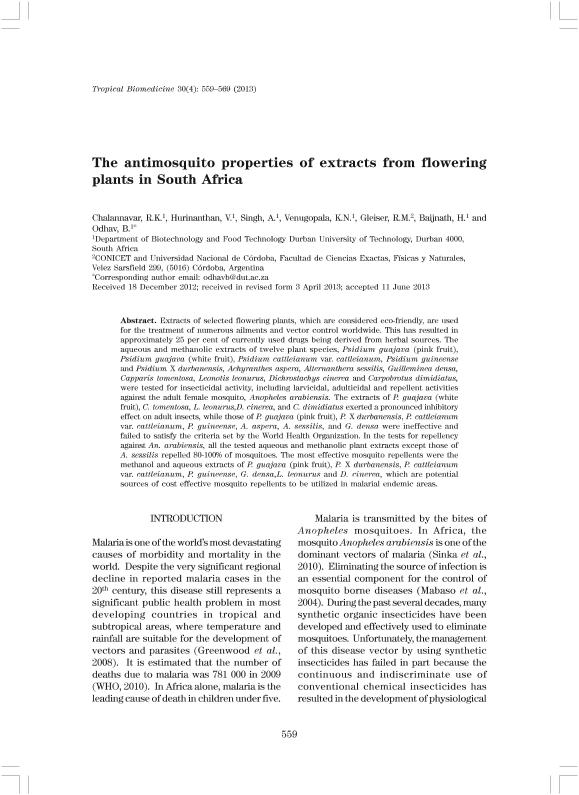Mostrar el registro sencillo del ítem
dc.contributor.author
Chalannavar, R.K.
dc.contributor.author
Hurinanthan, V.
dc.contributor.author
Singh, Ajnesh

dc.contributor.author
Venugopala, K.N.
dc.contributor.author
Gleiser, Raquel M.

dc.contributor.author
Baijnath, H.
dc.contributor.author
Odhav, B.
dc.date.available
2017-08-25T20:07:36Z
dc.date.issued
2013-12
dc.identifier.citation
Chalannavar, R.K.; Hurinanthan, V.; Singh, Ajnesh; Venugopala, K.N.; Gleiser, Raquel M.; et al.; The antimosquito properties of extracts from flowering plants in South Africa; Malaysian Soc Parasitology Tropical Medicine; Tropical Biomedicine; 30; 4; 12-2013; 559-569
dc.identifier.issn
0127-5720
dc.identifier.uri
http://hdl.handle.net/11336/23032
dc.description.abstract
Extracts of selected flowering plants, which are considered eco-friendly, are used for the treatment of numerous ailments and vector control worldwide. This has resulted in approximately 25 per cent of currently used drugs being derived from herbal sources. The aqueous and methanolic extracts of twelve plant species, Psidium guajava (pink fruit), Psidium guajava (white fruit), Psidium cattleianum var. cattleianum, Psidium guineense and Psidium X durbanensis, Achyranthes aspera, Alternanthera sessilis, Guilleminea densa, Capparis tomentosa, Leonotis leonurus, Dichrostachys cinerea and Carpobrotus dimidiatus, were tested for insecticidal activity, including larvicidal, adulticidal and repellent activities against the adult female mosquito, Anopheles arabiensis. The extracts of P. guajava (white fruit), C. tomentosa, L. leonurus,D. cinerea, and C. dimidiatus exerted a pronounced inhibitory effect on adult insects, while those of P. guajava (pink fruit), P. X durbanensis, P. cattleianum var. cattleianum, P. guineense, A. aspera, A. sessilis, and G. densa were ineffective and failed to satisfy the criteria set by the World Health Organization. In the tests for repellency against An. arabiensis, all the tested aqueous and methanolic plant extracts except those of A. sessilis repelled 80-100% of mosquitoes. The most effective mosquito repellents were the methanol and aqueous extracts of P. guajava (pink fruit), P. X durbanensis, P. cattleianum var. cattleianum, P. guineense, G. densa,L. leonurus and D. cinerea, which are potential sources of cost effective mosquito repellents to be utilized in malarial endemic areas.
dc.format
application/pdf
dc.language.iso
eng
dc.publisher
Malaysian Soc Parasitology Tropical Medicine

dc.rights
info:eu-repo/semantics/openAccess
dc.rights.uri
https://creativecommons.org/licenses/by-nc-sa/2.5/ar/
dc.subject
Anopheles Arabiensis
dc.subject
Larvicidal
dc.subject
Repellent
dc.subject
Insecticidal
dc.subject.classification
Bioquímica y Biología Molecular

dc.subject.classification
Ciencias Biológicas

dc.subject.classification
CIENCIAS NATURALES Y EXACTAS

dc.title
The antimosquito properties of extracts from flowering plants in South Africa
dc.type
info:eu-repo/semantics/article
dc.type
info:ar-repo/semantics/artículo
dc.type
info:eu-repo/semantics/publishedVersion
dc.date.updated
2016-12-12T14:16:22Z
dc.journal.volume
30
dc.journal.number
4
dc.journal.pagination
559-569
dc.journal.pais
Malasia

dc.description.fil
Fil: Chalannavar, R.K.. Durban University of Technology; Sudáfrica
dc.description.fil
Fil: Hurinanthan, V.. Durban University of Technology; Sudáfrica
dc.description.fil
Fil: Singh, Ajnesh. Durban University of Technology; Sudáfrica
dc.description.fil
Fil: Venugopala, K.N.. Durban University of Technology; Sudáfrica
dc.description.fil
Fil: Gleiser, Raquel M.. Universidad Nacional de Córdoba. Facultad de Ciencias Exactas, Físicas y Naturales; Argentina. Consejo Nacional de Investigaciones Científicas y Técnicas; Argentina
dc.description.fil
Fil: Baijnath, H.. Durban University of Technology; Sudáfrica
dc.description.fil
Fil: Odhav, B.. Durban University of Technology; Sudáfrica
dc.journal.title
Tropical Biomedicine

dc.relation.alternativeid
info:eu-repo/semantics/altIdentifier/url/http://msptm.org/journal-vol-30-no-4/
Archivos asociados
